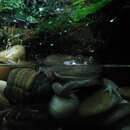Brief Summary
provided by IABIN
Diagnosis A large, stout ceratophryine frog, gray or reddish dorsally, with axillary and inguinaI spots bright orange or skin warty. Interocular distance subequal to upper eyelid; a large, segmented, vertebral shield on the back.
- author
- Esteban O. Lavilla
- editor
- Diego Arrieta
Distribution
provided by IABIN
Known from La Rioja, Formosa, Córdoba, Salta, Catamarca, Santiago del Estero, and Chaco provinces, Argentina, and also from adjacent Paraguay (Departamento Alto Paraguay).
- author
- Esteban O. Lavilla
- editor
- Diego Arrieta
Diagnostic Description
provided by IABIN
Adult morphology Snout-vent of about 65-75 mm in males, 65-100 mm in females. Body stout; forelegs and hindlegs moderate. The tip of the third finger reaches thc axila; when hindleg is adpressed, heel renches the tympanum. Head broad, snout sloping. Nostrils very close to the eye. Eye dorsally located, prominent. Interocular distance subequal to the upper eyelid and equal to the internarial interval. Diameter of the eye equal to the interocular distance and to its distance from nostril. Tongue subcircular, about 1/3 as wide as mouth opening. Vomerine teeth very small, in two separated patches between the choanae. Cephalic bones desmostosed, finely ornamented. Tympanum small, dorsal, about 2/3 of the eye diameter. Its distance from the eye about twice its own diameter. Fingers free: toes 1/3 webbed, and fringed. Rate of the finger lengths: II-I-IV-III. Metacarpal tubercle break. The inner metatarsal tubercle spade-like, black; the outer indistinguishable. Tarsal fold evident. Dorsal skin warty: a rounded, segmented, flat vertebral shield on the dorsum. Ventrally closely granular. Bilateral vocal sacs and brownish nuptial pads in males. Color brownish or reddish on the dorsum. Axillari and inguinal spots bright orange. Ventrally whitish, unspotted. Larval morphology Body strongly depressed; "ray"-shaped in dorsal view; laterally, thin protuberant processes cover the gill region; body twice as wide as greatest depth; width of body four-fifths its length; tail one and three-fourths as long as body; tail pointed, three times as long as its greatest depth, musculature extends to tip of tail; dorsal fin of tail transparent, high, extending onto posterior one-fourth of body; vent median; anal tube long, medial. Eyes heavily pigmented, situated dorsally, oriented anteriad; interorbital distance about one-fourth as wide as width of body; nostrils much closer to eyes than to tip of snout; internarial distance one-half interorbital distance; peribranchial chamber expanded ventrally, open posteriorly in younger individuals, and closing medially before metamorphosis. Mouth ventral, nearly terminal, very large; lips broad; buccal papillae scattered in single row: around mouth; horny beak present at no time during development; faint tooth rows on anterior lip; a weaker row on posterior lip. Coloration: Body pale with weakly pigmented blotches; tail pale with dorsal stripe of scattered spots.
- author
- Esteban O. Lavilla
- editor
- Diego Arrieta
Lepidobatrachus llanensis: Brief Summary
provided by wikipedia EN
Lepidobatrachus llanensis (common name: llanos frog; in Spanish: escuerzo) is a species of frogs in the family Ceratophryidae. It is found in northern Argentina, western Paraguay, and southern Bolivia.
- license
- cc-by-sa-3.0
- copyright
- Wikipedia authors and editors

